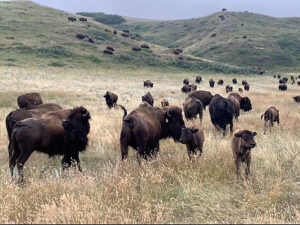Regenerative agriculture gaining traction in industry
By Lethbridge Herald on February 22, 2021.
 Submitted photo
Bison graze at the Sweetgrass Bison ranch near Lethbridge. Sweetgrass Bison is one of many cattle or cropping operations in North America utilizing the benefits of regenerative agriculture to increase soil health and enhance the profitability of their operations.
Submitted photo
Bison graze at the Sweetgrass Bison ranch near Lethbridge. Sweetgrass Bison is one of many cattle or cropping operations in North America utilizing the benefits of regenerative agriculture to increase soil health and enhance the profitability of their operations.Tim Kalinowski
Lethbridge Herald
tkalinowski@lethbridgeherald.com
Regenerative agriculture is a term gaining popularity and credence in the modern day farming and ranching industry.
It refers to a set of farming practices carried out with the specific intention of enhancing the quality of the soil base by using creative natural methods. It could refer to short rotation grazing, for example, or cover cropping to enhance the amount of biomass in the soil.
“Regenerative agriculture is not one specific practice,” explains Cody Spencer, owner of Sweetgrass Bison located near Lethbridge and a member of Regeneration Canada.
“It is not a formula. It’s a variety of different practices that are applied in land management, whether it is farming, ranching, gardening, with the intent of building up the health of the soil.”
“Soil is the foundation for all life on the planet,” he adds, “and with a large part of our economy in southern Alberta being agriculture-based the importance of soil health cannot be overstated.
“Our soils here in southern Alberta, and all across the Prairies, have been built over thousands of years through natural processes and grazing. There has been this pumping of carbon into the soil building up this rich bank which is the foundation of our agricultural systems.
“Over the last 150 years, we have been drawing from that bank and not replenishing enough of that resource.”
Regeneration Canada is holding its virtual Living Soil Symposium this week to draw awareness of the importance of regenerative agricultural practices, and is trying to spread the regenerative message to farmers and producers throughout the country.
Regeneration Canada also provides a map of and contact information for current regenerative agricultural practitioners so anyone wanting more information on how regenerative agriculture works can get that information directly from the horse’s mouth.
“The adoption of regenerative agriculture is still pretty low at this point, but it is growing,” confirms Spencer. “We have a burgeoning movement around regenerative agriculture practitioners here in southern Alberta, and across the Canadian Prairies. And really all across North America. It has really been picking up over the past few years and gaining attention. It’s exciting to see, because people are realizing they have to look at a different system to reduce input costs and increase profitability.
“People are realizing that is now tied to the health of the soil.”
As someone who uses short rotation grazing himself in his bison operation, Spencer says he can see the benefits to his land of using these practices. In his case, he uses portable, solar powered electric fencing and water systems to continuously move his livestock in a controlled way through his rangeland; thereby ensuring no part of his land is overgrazed and every inch of his pasture gets the natural benefits which come with grazing.
“We want to graze it in a way that bison herds historically would have done it,” he explains.
“We graze a pasture for a short period of time, and then we move our animals off. By moving those animals off, and allowing those grasslands to recover, creates a very healthy stand of grassland which has huge implications for wildlife habitat, water storage, and profit back to the rancher.”
For more information on regenerative agriculture, and to see the local practitioners map, visit https://regenerationcanada.org/en/
Follow @TimKalHerald on Twitter
-1


